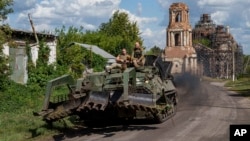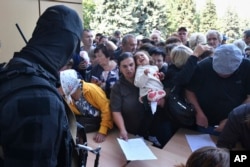Superb Ukrainian intelligence and U.S.-provided weaponry are being credited for enabling the rapid advance of Ukrainian forces into Russian territory over the past week. Some analysts believe they could move even faster if Washington allowed them to use the most sophisticated weapons at their disposal.
The Ukrainian troops continued their advance through the Kursk region on Wednesday, Day 9 of the first such incursion onto Russian soil since World War II. Ukrainian forces now control up to 1,000 square kilometers of land and more than 70 settlements inside Russia.
“The grouping of defense forces continues to conduct an offensive operation on the territory of the Kursk region,” Ukraine’s top military commander, General Oleksandr Syrskyi, told President Volodymyr Zelenskyy during a video conference on Wednesday. “Since the beginning of this day, Ukrainian troops have advanced from one to two kilometers.”
Vladislav Seleznyov, a former spokesman for the Ukrainian armed forces’ general staff, told VOA’s Russian Service that Ukrainian intelligence and the U.S.-provided High Mobility Artillery Rocket Systems, known as HIMARS, had been critical to the stunning advance.
“Ukrainian intelligence worked perfectly,” he said. “Therefore, some of the enemy columns rushing to the aid of the Russian army in the Kursk region were destroyed thanks to artillery and drones. Perhaps aviation.
“And of course, the real scourge of the Russian army is the HIMARS, which turn into ashes a huge amount of weapons, equipment and personnel of the Russian army,” he said.
Still, the pace of the Ukrainian advance has slowed over the past few days — due not so much to Russian troops’ resistance as to the Ukrainian forces’ stretched supply lines.
The key to countering this disadvantage, according to some experts, is Ukraine being given greater discretion to use Western long-range weapons — in particular, the MGM-140 Army Tactical Missile System, or ATACMS, featuring a tactical ballistic missile that can fly up to 300 kilometers.
“I think Washington is the main problem here,” said John Hardie, deputy director of the Russian Program at the Foundation for Defense of Democracies.
“If the U.S. had given the green light to the ATACMS, their use on Russian territory, I think the British and perhaps the French would have followed suit with their cruise missiles that they have supplied to Ukraine,” Hardie told VOA.
“I think these weapons would be useful in this offensive, including for striking Russian command posts, logistics hubs or other targets further away than HIMARS can reach,” he said.
Despite the success of the Ukrainian forces in Russia’s Kursk region, Russia continues to conduct its offensive along the front in eastern Ukraine, with its forces pressuring such towns as Pokrovsk and Toretsk.
Still, according to Angela Stent, a nonresident senior fellow at the Brookings Institution and professor emerita at Georgetown University, Ukraine’s move into Kursk should not be seen as “an act of desperation.”
“I would say that the Ukrainians have tried to give the Russians a dose of their own medicine: to cause some uncertainty in Russia, and perhaps to question the competence of the Russian military,” she told VOA. “And they achieved it.”
Despite having to defend Russian soil for the first time in decades, Russian President Vladimir Putin — who has insisted since it started on calling his full-scale invasion of Ukraine a “special military operation” — still seems reluctant to admit that he has taken his country to war.
Since last week, he has been describing the Ukrainian offensive as a “large-scale provocation” and on Tuesday he announced the start of a “counter-terrorist operation” in response.
According to Russian political analyst Ivan Preobrazhensky, Putin is carefully couching his language because he does not want to draw attention to the failure to defend the country’s borders.
Meanwhile, Russian armed forces are reportedly digging trenches to protect parts of the Kursk region they still control — including around the village of Viktorovka, about 45 kilometers from Russia’s border with Ukraine — while officials in Kyiv discuss the possible creation of a military commandant’s office in the Russian territory now occupied by Ukrainian troops.
This article originated in VOA’s Russian Service.









